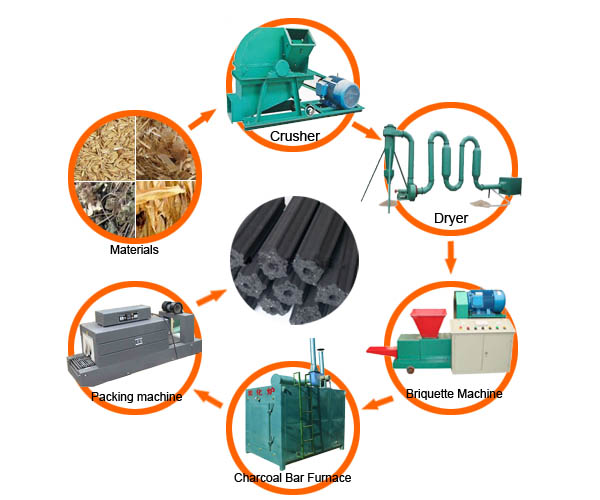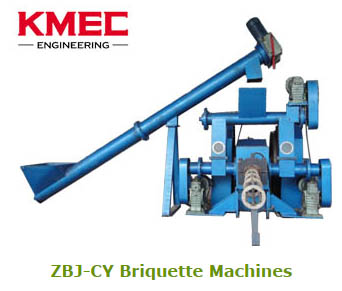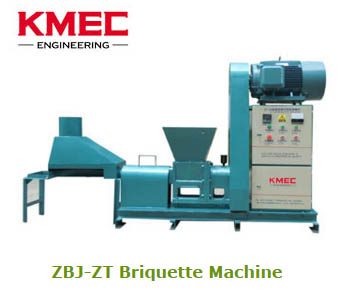Charcoal briquette machine turn waste into energy
Charcoal is a desirable fuel because it produces a hot, long-lasting, virtually smokeless fire. Combined with other materials and formed into uniform chunks called briquettes, it is popular used for outdoor cooking in the United States.Basic charcoal is produced by burning a carbon-rich material such as wood in a low-oxygen atmosphere. This process drives off the moisture and volatile gases that were present in the original fuel. The resulting charred material not only burns longer and more steadily than whole wood, but it is much lighter.
Then how the
briquette machine makes briquettes charcoal?

There are four steps to make biomass waste into briquettes charcoal. First, biomass material shall be crushed into powder and fine granule. Second, crushed material is bound to being dried to 15% or so. Third, charcoal briquette machine are capable of squeezing raw material into briquettes. Last but not least, briquettes can be carbonized into charcoal with charcoal machines or carbonizing furnace. Specifically, charcoal briquette machines are chiefly used to turn biomass waste into biomass briquettes, the process of which is usually called deeper processing of biomass material whose application is different from charcoal. Business briquettes are usually used for heating and power generation, and another use of it remains to be made into charcoal. Different materials demand distinguished compression ratios, which is usually ignored by clients. Therefore, some client may want to know the reasons for failure of briquetting even after propeller adjustment and inspection upon wear and tear. The fineness and hardness of material exert some impact upon the compression ratio of screw rod. As a matter of fact, a variety of materials can be squeezed into briquettes such as rice husk, peanut shell, cotton stalks, corn cobs and stalks, sorghum stalks, bean stalks, saw shavings, coconut shell and so on. And saw shavings as well as bamboo off cut and rice husk of all the kinds are the ideal ones. Charcoal briquette press enjoys a quite extensive market. Electro welding technology can just help the rod to survive for 30 hours or so while oxygen or spray welding is capable of cracking the problem of high temperature resistance. Besides, wear-resistant material under electro welding cannot smelt into steel material evenly, the latter of which is made into screw rods. Charcoal briquettes machines take waste material, off cut and residue of agriculture, forestry and industry as raw material to produce biomass briquette fuel which can be further carbonized into charcoal with charcoal machine or carbonizing furnace.
Fuel briquettes generated by the low-pressure compaction of paper, sawdust, agricultural or yard waste, etc. currently serve as an alternative to firewood, wood pellets and charcoal in developing countries in Africa, Asia and South America.The energy content of briquettes ranged from 4.48 to 5.95 kilojoule per gram (kJ/g) depending on composition, whereas the energy content of sawdust, charcoal and wood pellets ranged from 7.24 to 8.25 kJ/g. Biobriquettes molded into a hollow-core cylindrical form exhibited energy output comparable to that of traditional fuels. The study demonstrates that low-energy content feedstocks can be composted, pressed and combusted to produce heat output commensurate with higher energy content fuels.
Calorimetric Analysis
A Parr oxygen bomb calorimeter interfaced to a Vernier Logger Pro thermocouple was used to determine the caloric content of the biobriquette materials relative to traditional fuel sources. Bomb (or constant volume) calorimetry experiments were performed by traditional methods . Briefly, the sample to be tested was grated, filtered with a 20-mesh sieve and then pressed into a 1 gram (g) pellet. Ignition of material under 2.533 megapascal oxygen (MPa O2) resulted in an observed temperature increase of the steel bomb vessel. The caloric content of the material was then calculated while taking into account corrections for unoxidized fuse wire. The heat capacity of the calorimeter was calibrated with benzoic acid and naphthalene standards
Combustion Analysis
The combustion tests were carried out in a fume hood with a face velocity of 30.5 meters (m) per second, to provide a steady flow of air. Biobriquettes, weighing on the order of 100 g each, were placed on a wire mesh stand 21 centimeters from the floor of the hood and enclosed in a modified Weber chimney stove topped with wire mesh. A Bunsen burner placed under the briquette served as the ignition source. Once the biobriquette had begun to combust, the ignition source was removed and a 2-liter (L) aluminum saucepan containing 500 milliliters (mL) of deionized water was placed on top of the stove (Figure 2). This process was implemented in order to monitor the heat output from the biobriquette once the Bunsen burner was removed. The temperature of the water bath was recorded by the Vernier Logger Pro device interfaced to a computer, which measured the temperature change in the water every second over a span of 4,000 seconds (just over an hour). The four types of briquettes mentioned earlier were combusted in this study. In addition, traditional fuels including charcoal, wood and wood pellets were ignited and energy output was monitored under the same set of conditions (i.e. mass of 100 g, consistent ignition time by Bunsen burner, same method of recording heat output). Briquettes of each composition were tested from two to four times whereas traditional fuel sources were tested thrice each.
-------------------------------------------------------------------------------------------------------------
Charcoal briquette produced with Kingman charcoal briquette machine can be used in a wide range of sectors. And we hereby would like to set you up with the extensive application of charcoal briquette and charcoal material processed from briquette so that you will get to know the advantages of use of charcoal briquette machine.




